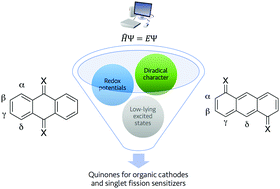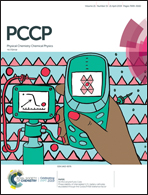Improvement of the electrochemical and singlet fission properties of anthraquinones by modification of the diradical character†
Abstract
In this work, theoretical methods of quantum chemistry are employed to estimate the effects that the structural modification of 1,5- and 9,10-anthraquinone molecules might produce in their electronic structure, in the pursuit of a common strategy to improve the electrochemical and singlet fission features of conjugated quinones. The proposed modifications are the following: (i) substitution of the carbonyl oxygen atom, (ii) insertion of heteroatoms in the carbon backbone, and (iii) introduction of electron-withdrawing and electron-donating substituents in different positions of the rings. This work shows how specific modifications of the electronic structure can be used to tune the electrochemistry and photophysics of the quinones, improving their suitability to be singlet fission sensitizers and cathode materials. As it was previously known, intermediate diradical characters favor the accomplishment of the singlet fission process. This can be achieved for 1,5-anthraquinone by introduction of B and Si atoms and electron-donating groups in low spin density positions of the carbon backbone or N atoms in high spin density positions. The introduction of heteroatoms or substituents in 9,10-anthraquinone hardly facilitates the singlet fission process. Regarding the electrochemistry, it is observed that the reduction potentials greatly depend on the nature of the modification rather than on the diradical character.



 Please wait while we load your content...
Please wait while we load your content...